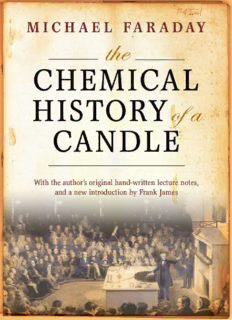
The chemical history of a candle : with a facsimile reproduction of Faraday's manuscript lecture notes from Royal Institution MS F4 J21 PDF
Preview The chemical history of a candle : with a facsimile reproduction of Faraday's manuscript lecture notes from Royal Institution MS F4 J21
THE CHEMICAL HISTORY OF A CANDLE Photograph of Michael Faraday by John Watkins, c. April 1861 MICHAEL FARADAY THE CHEMICAL HISTORY OF A CANDLE SESQUICENTENARY EDITION with a facsimile reproduction of Faraday’s manuscript lecture notes from Royal Institution MS F4 J21 EDITED AND INTRODUCED BY FRANK A. J. L. JAMES Great Clarendon Street, Oxford OX2 6DP Oxford University Press is a department of the University of Oxford. It furthers the University’s objective of excellence in research, scholarship, and education by publishing worldwide in Oxford New York Auckland Cape Town Dar es Salaam Hong Kong Karachi Kuala Lumpur Madrid Melbourne Mexico City Nairobi New Delhi Shanghai Taipei Toronto With offices in Argentina Austria Brazil Chile Czech Republic France Greece Guatemala Hungary Italy Japan Poland Portugal Singapore South Korea Switzerland Thailand Turkey Ukraine Vietnam Oxford is a registered trade mark of Oxford University Press in the UK and in certain other countries Published in the United States by Oxford University Press Inc., New York © Frank A. J. L. James 2011 The moral rights of the author have been asserted Database right Oxford University Press (maker) First published 2011 All rights reserved. No part of this publication may be reproduced, stored in a retrieval system, or transmitted, in any form or by any means, without the prior permission in writing of Oxford University Press, or as expressly permitted by law, or under terms agreed with the appropriate reprographics rights organization. Enquiries concerning reproduction reprographics rights organization. Enquiries concerning reproduction outside the scope of the above should be sent to the Rights Department, Oxford University Press, at the address above You must not circulate this book in any other binding or cover and you must impose the same condition on any acquirer British Library Cataloguing in Publication Data Data available Library of Congress Cataloging in Publication Data Data available Typeset by SPI Publisher Services, Pondicherry, India Printed in Great Britain on acid-free paper by Clays Ltd, St Ives plc ISBN 978–0–19–969491–4 1 3 5 7 9 10 8 6 4 2 In Memoriam A. Rupert Hall (1920–2009) Marie Boas Hall (1919–2009) CONTENTS Foreword Acknowledgements List of Plates Introduction Note on the Published Text The Text Notes The Facsimile Original Page Running Heads FOREWORD Anyone fortunate enough, as I was, to spend ten years at the Royal Institution carrying out laser research and lecturing for the young can testify that to this day Faraday’s spirit exudes from every pore of the Institution. In 1980-9, the building had a faded elegance redolent of that in Faraday’s time. There was much dust in the atmosphere, which made tuning our lasers very difficult—students grappling with this task were comforted with the thought that some of the dust may have been Faraday’s own skin cells! We viewed our efforts with that most modern of light sources as being in direct descent from Faraday’s own original light source, the candle. It is wonderful that Faraday’s Chemical History of a Candle is to be re-issued, not only as an historical document, but also as a lesson in how to communicate science. I have lectured well over one hundred times in that historic theatre, and gave four Friday Evening Discourses, and (jointly) the 1987-8 BBC-TV Christmas Lectures on ‘Crystals and Lasers’. Every time one entered the theatre to begin a lecture, one felt a tension best described as having Faraday looking over one’s shoulder criticizing delivery and content. His collected writings, published as Advice to Lecturers, still good today, was always available to Royal Institution lecturers, and provided sobering reading if one’s prepared lecture did not conform with Faraday’s views on how it should be done: An experimental lecturer should attend very carefully to the choice he may make of experiments for the illustration of his subject. They should be important . . . clear . . . rather approach to simplicity, and explain the established principles of the subject, than be elaborate . . . A flame should be lighted at the commencement, and kept alive with unremitting splendour to the end. Readers of this new edition of Chemical History of a Candle will find a text that amply demonstrates Faraday’s capabilities to engage and enthuse an audience; a process as necessary today as it was then. Enjoy it! David Phillips Professor Emeritus, Imperial College London President, Royal Society of Chemistry Royal Institution Christmas Lecturer, 1987–8 11 January 2011
Description: